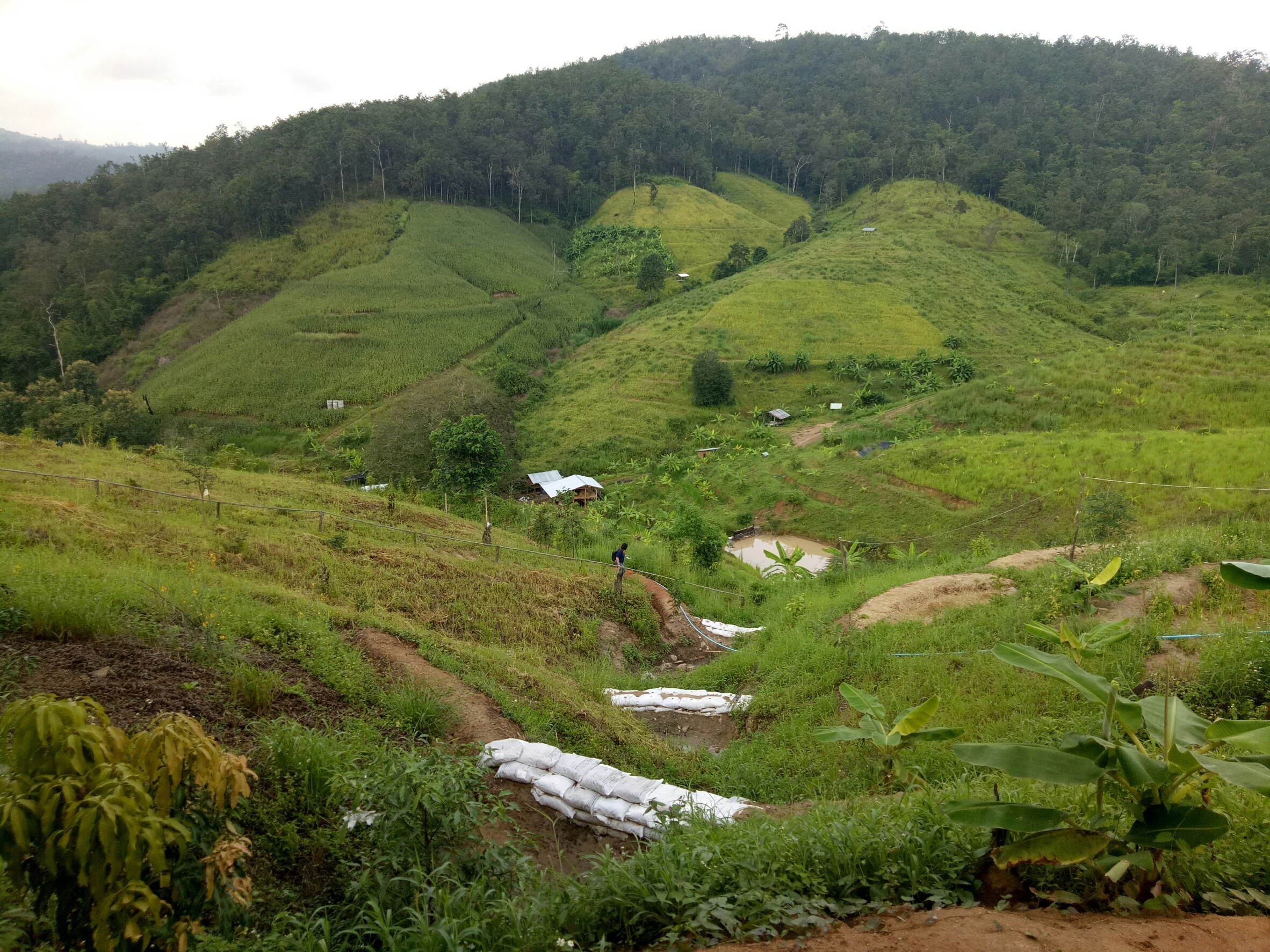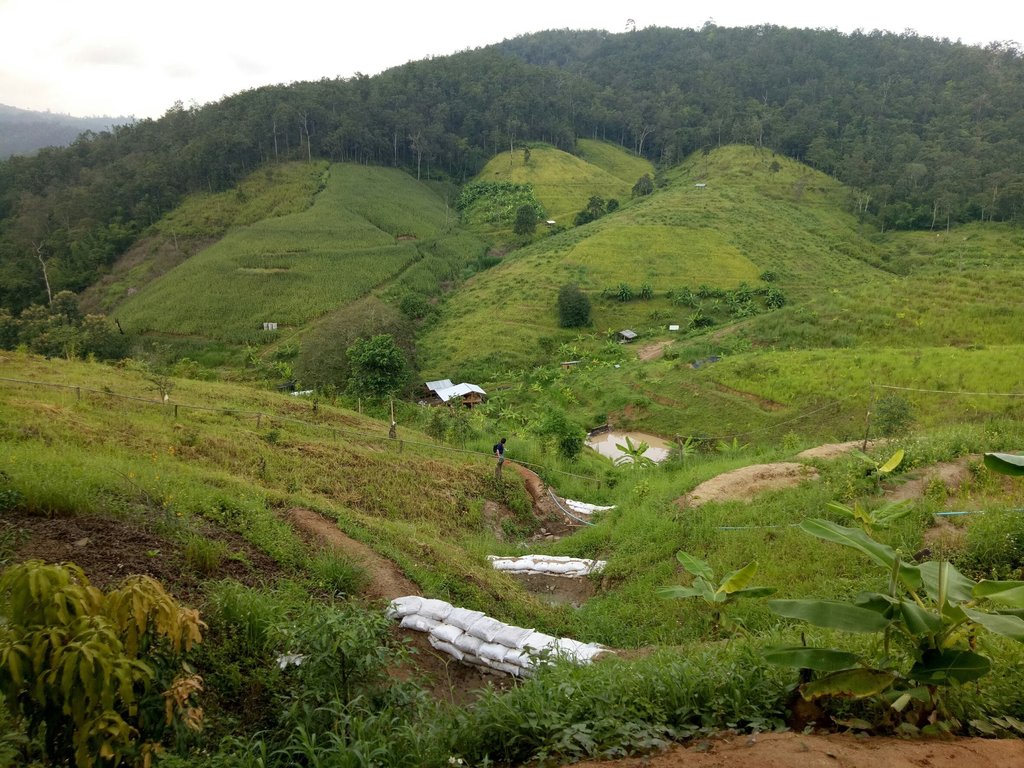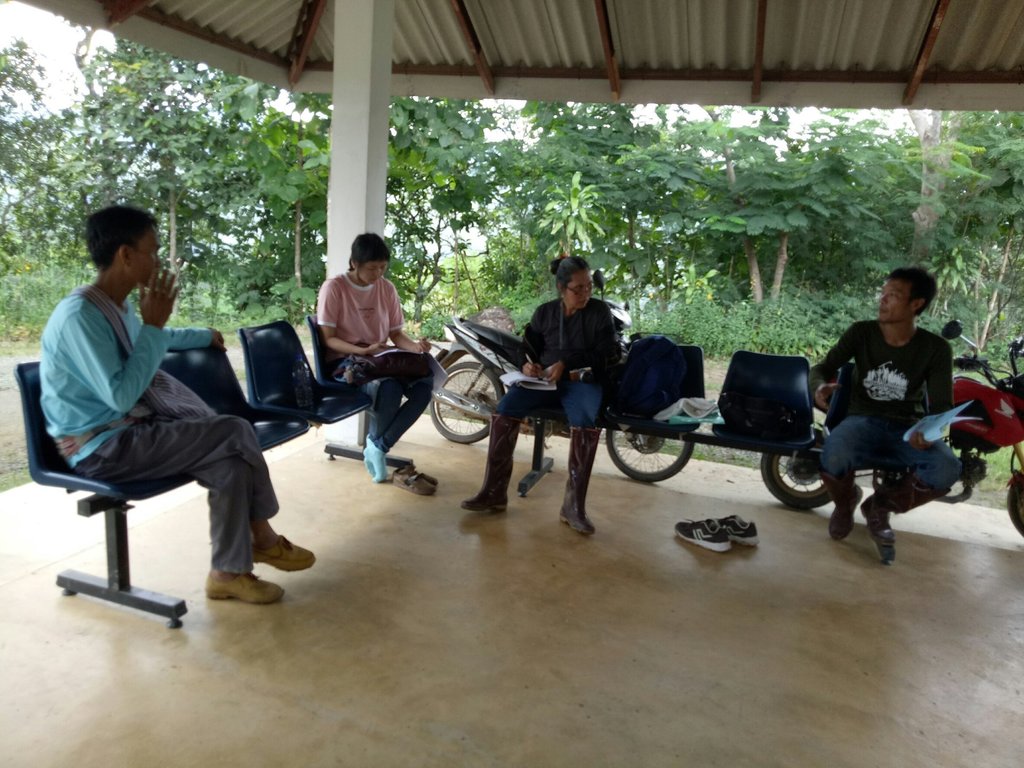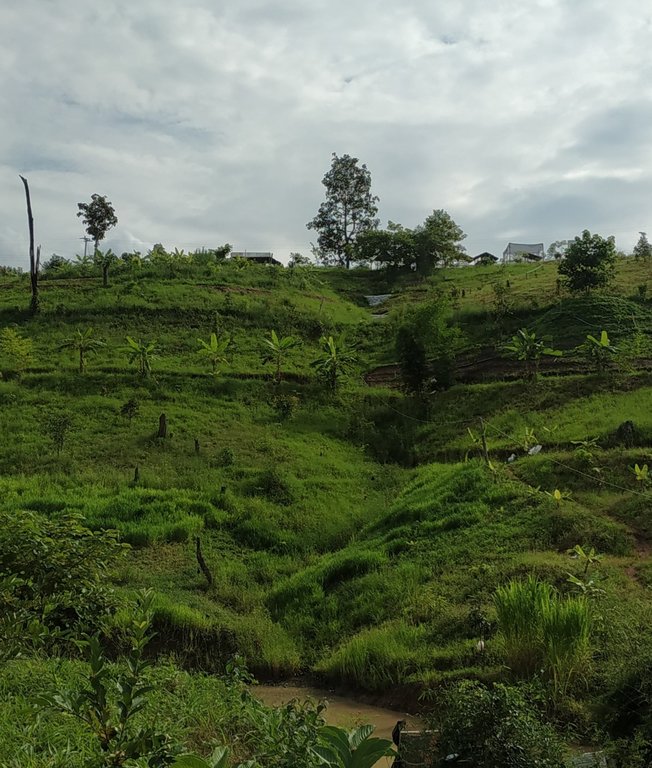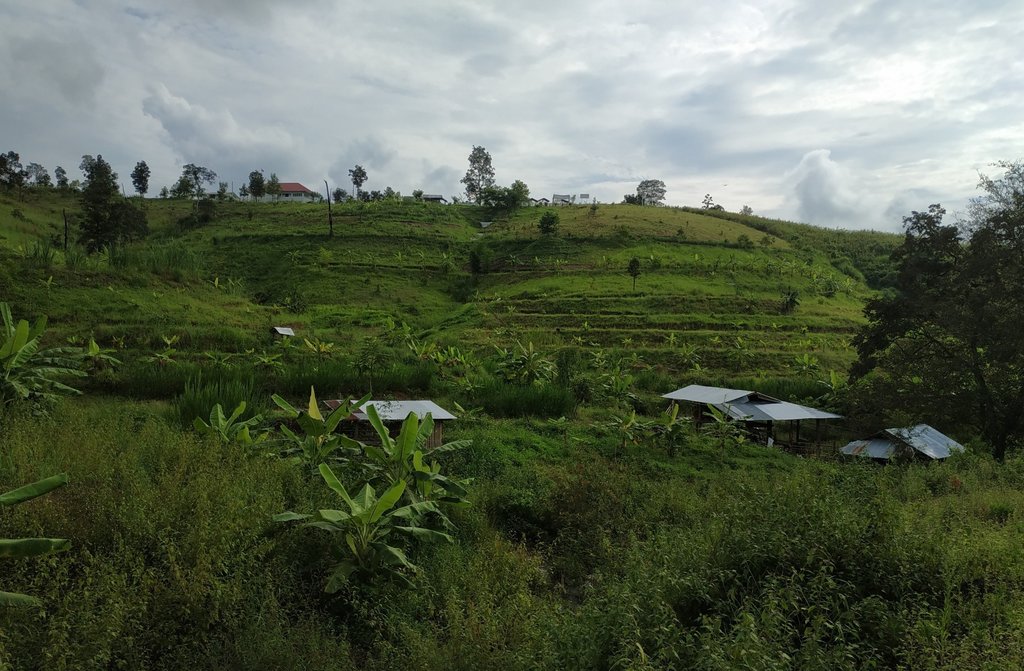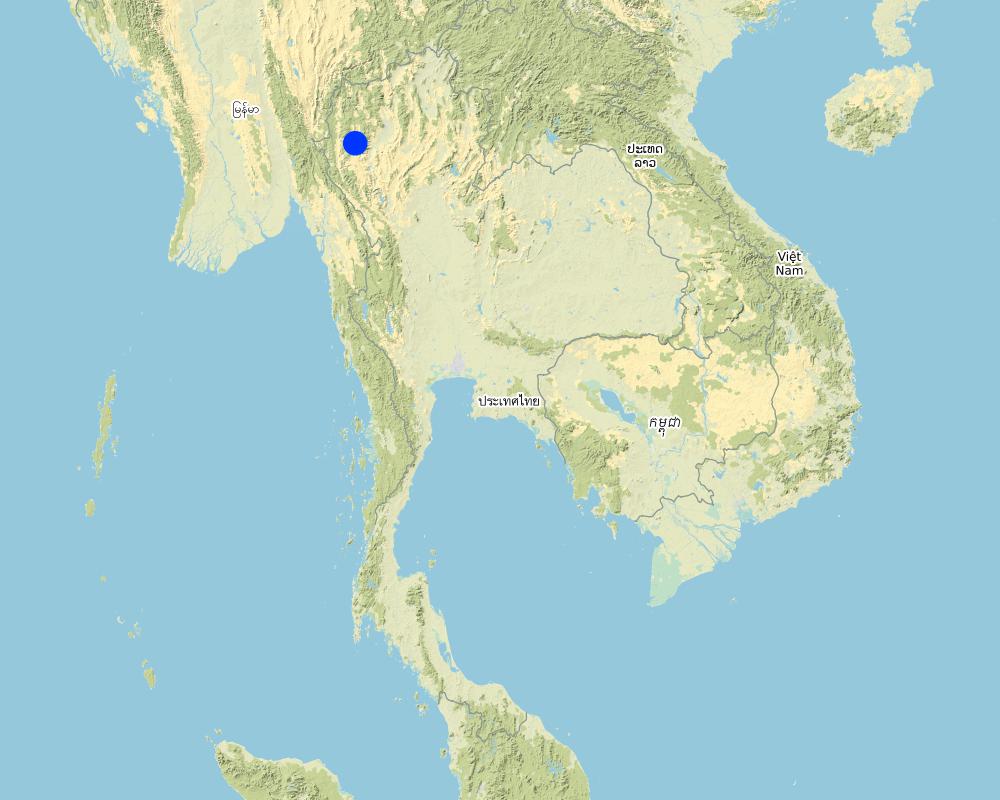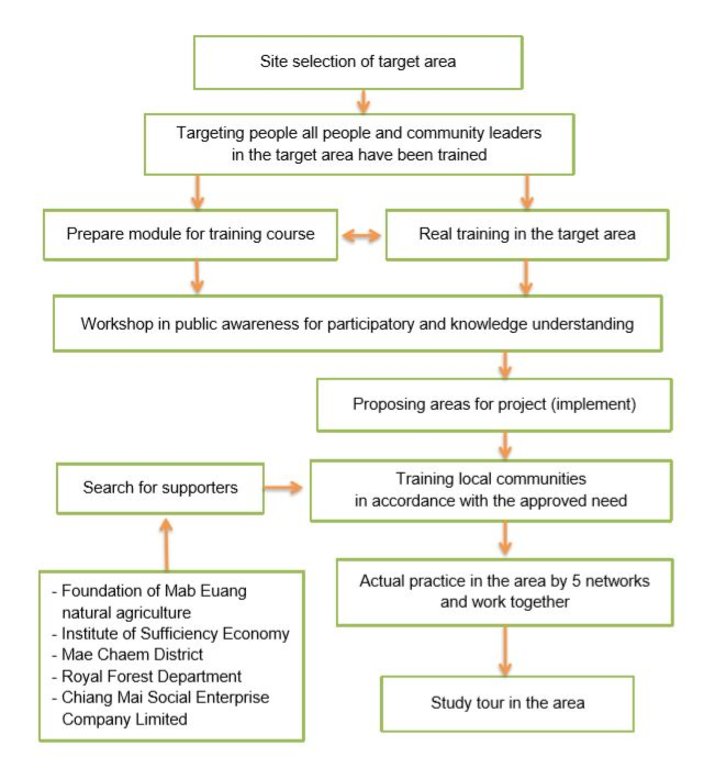Returning Life to Mae Chaem Watershed by Integrated Land and Water Management [Thaïlande]
- Création :
- Mise à jour :
- Compilateur : Pitayakon Limtong
- Rédacteur : –
- Examinateurs : Rima Mekdaschi Studer, William Critchley
Integrated land and water management in landscape of Khok-Nong-Na model
approaches_4280 - Thaïlande
Voir les sections
Développer tout Réduire tout1. Informations générales
1.2 Coordonnées des personnes-ressources et des institutions impliquées dans l'évaluation et la documentation de l'Approche
co-compiler:
co-compiler:
1.3 Conditions relatives à l'utilisation par WOCAT des données documentées
Quand les données ont-elles été compilées (sur le terrain)?
12/09/2018
Le compilateur et la(les) personne(s) ressource(s) acceptent les conditions relatives à l'utilisation par WOCAT des données documentées:
Oui
2. Description de l'Approche de GDT
2.1 Courte description de l'Approche
The promotion of a model that supports sustainable cultivation outside the protected forest area in the northern highlands of Thailand. The model is based on the knowledge of King Bhumibol Adulyadej (King Rama 9). It is a prototype model of the Institute of Sufficiency Economy and the Foundation for Natural Agriculture, and uses the New Theory Approach in Agriculture to build a self-sufficiency economy.
2.2 Description détaillée de l'Approche
Description détaillée de l'Approche:
This is the approach that supports "returning life" to the Mae Chaem area by an integrated land and water management system in the highlands, through the King Rama 9 initiative combined with local wisdom: or the "Khok-Nong-Na model". Most of this area is in Mae Chaem Reserved National Forest, an upstream watershed which is strictly preserved as forest and does not officially allow people to live and cultivate. However, communities have been earning their living there for a long time before the reserved forest law was announced, which deprived them of the right to own the land and use it for agriculture. Previously all land users earned income by encroaching into Mae Chaem National Forest Reserve - and converting it into maize, shallot and cabbage fields. The forest area was intruded upon, making the soil erode, and therefore soil fertility and productivity decreased. The integrated water management system by King Rama 9’s initiative together with local wisdom, is a prototype model at the Sufficiency Economy Institute and the Natural Agriculture Foundation, supporting the “New Theory of Agriculture” based on a self-sufficiency economy. The Foundation has explained to all land users that this concept called "Khok-Nong-Na" divides the area into 30:30:30:10 portions as follows; 30% for water sources (farm ponds, small water channels), 30% for rice fields, 30% for trees, and 10% for housing and animals. Implementation of Khok-Nong-Na models will depend on the topography of the area are as follow:
1. Upland or "mound" (Khok) is the highland area as part of the mountain or hill to cultivate "three kinds of trees” as forests, namely "three forests, four benefits". “Three kinds of forests” means for consumption, construction and economy, while the fourth benefit is to preserve the ecosystem.
2. Reservoir (Nong), the lowland area as part of water resources, includes the checkdam or weir, the sediment trap, the water channel and the pond, for both consumption and agricultural use. The checkdam or weir in the upper area serves as a storage and to control the flow rate of water. The water channel is designed to deliver water to the pond or reservoir in the lower area.
3. Paddy field (Na) is an important component for rice cultivation because rice is the main staple. Rice terraces are established in the sloping area, with paddy fields in the lowland. The main purpose of rice production is for the farmer family’s consumption - as well as for income. The ridges around the rice terraces field should be high and wide to store greater amounts of water - as the water level in the paddy field can control weeds, accelerate plant growth and improve crop yields. The native rice variety grown in rich soil is immune to diseases and insects.
2.3 Photos de l'approche
2.4 Vidéos de l'Approche
Date:
12/09/2018
2.5 Pays/ région/ lieux où l'Approche a été appliquée
Pays:
Thaïlande
Région/ Etat/ Province:
Ban Thap Sub-district, Mae Chaem District, Chiang Mai Province
Autres spécifications du lieu :
Ban Thap Sub-district, Mae Chaem District
Map
×2.6 Dates de début et de fin de l'Approche
Indiquez l'année de démarrage:
2015
Si l'année précise est inconnue, indiquez approximativement quand l'Approche a démarré:
il y a moins de 10 ans (récemment)
Commentaires:
Almost land users faced problem about debt from the investment loan for their agricultural and other activities.
2.7 Type d'Approche
- fondé sur un projet/ programme
2.8 Principaux objectifs de l'Approche
The integrated land management of Khok-Nong-Na model "returns life to the watershed" by protecting the ecosystem and simultaneously promoting sustainable and productive farming.
2.9 Conditions favorisant ou entravant la mise en œuvre de la(des) Technologie(s) appliquée(s) sous l'Approche
disponibilité/ accès aux ressources et services financiers
- entrave
They should stop borrowing money as they cannot find money to clear their debts.
collaboration/ coordination des acteurs
- favorise
Almost all land users help each other and collaborate to work together around twice a week.
charge de travail, disponibilité de la main-d'œuvre
- entrave
They have more workload in their field to do comfortably in one day and there are no labourers to hire in this area.
3. Participation et rôles des parties prenantes impliquées dans l'Approche
3.1 Parties prenantes impliquées dans l'Approche et rôles
- exploitants locaux des terres / communautés locales
Household network covers 21 members
All land users cooperate with each others
- ONG
Natural Agriculture Study Center
Support all knowledge in the New Theory for Agriculture (King Rama 9)
- secteur privé
Chiang Mai Social Enterprise Company Limited
Support seed of some crops and saplings of trees and fruit trees
- gouvernement local
Royal Forest Department and Mae Chaem District Administrative Organization
Create a project to manage to obtain multiple benefits from the forest for sustainable development by King Rama 9.
3.2 Participation des exploitants locaux des terres/ communautés locales aux différentes phases de l'Approche
| Participation des exploitants locaux des terres/ communautés locales | Spécifiez qui était impliqué et décrivez les activités | |
|---|---|---|
| initiation/ motivation | soutien extérieur | All land users normally face drought condition, making them unable to produce agricultural products properly, causing insufficient income and the debts of land users accumulate. |
| planification | interactive | Mae Chaem District Office set up a project to return life to all land users, so they can join and work together. |
| mise en œuvre | interactive | Land users work together with several networks in Khok-Nong-Na model with support from the Royal Forest Department, Natural Agriculture Study Center, Mae Chaem District Office and Chiang Mai Social Enterprise Company Limited. |
| suivi/ évaluation | auto-mobilisation | Monitor, evaluate and follow up by Deputy Minister of Agriculture and Cooperatives and Natural Agriculture Study Center with local officers in the area. |
3.3 Diagramme/ organigramme (si disponible)
Description:
Flow chart Operating procedures:
1. Site selection: the target area will be seen through 5 aspects: community, temple, school, government agency and appropriate topography, with 5 strong network sectors as: government, academic, private, civil social and mass media for sustainability and expansion of civil state
2. Targeting people: all people and community leaders in the target area have been trained at the Mab-Euang Natural Agriculture Foundation.
3. Training course: the main content is agricultural development to the sufficiency economy system by the Natural Agriculture Network. This is to take 5 days and 4 nights, consisting of application of New Theory of Agriculture in the concept of sufficiency economy combined with local wisdom for soil and water management for agricultural area.
4. Workshop: this activity is organized for farmers to learn about participation, extension and to understand the concept of sufficiency economy system.
5. Joint activity: people and communities in the area propose to implement this project and staff of the study center will consider and, when appropriate, approve the project.
6. Finding support agencies: the Mab-Euang Natural Agriculture Center for Sufficiency Economy System, Mae Chaem District Office, Royal Forest Department and Chiang Mai Enterprise Social Enterprise Company Limited.
7. Field training: this activity is the real field training in the selected area, where land users and community members have been trained according to the concept of Khok-Nong-Na model.
8. Area improvement: the practices in the targeted area consist of 5 networks that work together in the land user’s area in the concept of Khok-Nong-Na model with trees and fruit trees in upland and rice cultivation in lowland or rice terraces in upland, including farm ponds. Moreover, this area will be the training and study site for other people in this area.
9. Study center: if this area is completely set up and all components of the Khok-Nong-Na model are installed, the site should be upgraded to be a study center in the future. Now this project has increased cooperation among agencies, i.e. Royal Irrigation Department, Land Development Department, both under the Ministry of Agriculture and Cooperatives, Ministry of Natural Resources and Environment, and Department of Local Administration, Ministry of the Interior.
Auteur:
Ms. Somjit Lertdisayawan
3.4 Prises de décision pour la sélection de la Technologie/ des Technologies
Indiquez qui a décidé de la sélection de la Technologie/ des Technologies à mettre en œuvre:
- principalement les exploitants des terres soutenus par des spécialistes de la GDT
Expliquez:
All land users had been trained by several agencies, and let they decide the suitable technology to their area.
Spécifiez sur quelle base ont été prises les décisions:
- l'évaluation de connaissances bien documentées en matière de GDT (prises de décision fondées sur des preuves tangibles)?
4. Soutien technique, renforcement des capacités et gestion des connaissances
4.1 Renforcement des capacités/ formation
Une formation a-t-elle été dispensée aux exploitants des terres/ autres parties prenantes?
Oui
Spécifiez qui a été formé:
- exploitants des terres
Si pertinent, spécifiez le genre, l'âge, le statut, l'ethnie, etc.
-
Formats de la formation:
- entre agriculteurs (d'exploitants à exploitants)
- zones de démonstration
- cours
Thèmes abordés:
Agricultural development to achieve a self-sufficiency economy system.
Commentaires:
Training course 5 days and 4 nights before accepting to join the project.
4.2 Service de conseils
Les exploitants des terres ont-ils accès à un service de conseils?
Oui
Spécifiez si le service de conseils est fourni:
- dans les champs des exploitants?
Décrivez/ commentez:
Monitor, evaluate and follow up in the area.
4.3 Renforcement des institutions (développement organisationnel)
Des institutions ont elles été mises en place ou renforcées par le biais de l'Approche?
- oui, modérément
Spécifiez à quel(s) niveau(x), ces institutions ont été renforcées ou mises en place:
- local
Décrivez l'institution, ses rôles et responsabilités, ses membres, etc.
At present there are 21 household members in the group. There are rules and guidelines that indicate they must hold meetings and work together twice a week.
Précisez le type de soutien:
- équipement
Donnez plus de détails:
Tools to work in the area as spade, shovel, ploughs and also saplings of trees and fruit trees, and the costs for travelling, fuel and food when they work together.
4.4 Suivi et évaluation
Le suivi et l'évaluation font ils partie de l'Approche? :
Oui
Commentaires:
Monitor, evaluate and follow up by Natural Agriculture Study Center and also local officers.
Si oui, ce document est-il destiné à être utilisé pour le suivi et l'évaluation?
Non
Commentaires:
-
4.5 Recherche
La recherche a-t-elle fait partie intégrante de l’Approche?
Non
5. Financement et soutien matériel externe
5.1 Budget annuel de la composante GDT de l'Approche
Si le budget annuel précis n'est pas connu, indiquez une fourchette:
- > 1 000 000
5.2 Soutiens financiers/ matériels fournis aux exploitants des terres
Les exploitants des terres ont-ils reçu un soutien financier/ matériel pour la mise en œuvre de la Technologie/ des Technologies?
Oui
Si oui, spécifiez le(s) type(s) de soutien, les conditions et les fournisseurs:
Agricultural equipment for land users to set up Khok-Nong-Na model such as spade, shovel, plough and also saplings of soil, trees and fruit trees by the Deputy Minister of Agriculture and Cooperatives, and Natural Agriculture Study Center.
5.3 Subventions pour des intrants spécifiques (incluant la main d'œuvre)
- équipement
| Spécifiez les intrants subventionnés | Dans quelle mesure | Spécifiez les subventions |
|---|---|---|
| outils | en partie financé | Material and equipment for farming |
- intrants agricoles
| Spécifiez les intrants subventionnés | Dans quelle mesure | Spécifiez les subventions |
|---|---|---|
| semences | en partie financé | Seed of crops and saplings of trees and fruit trees |
Si la main d'œuvre fournie par les exploitants des terres était un intrant substantiel, elle était:
- volontaire
Commentaires:
The community network cooperative work together in their land.
5.4 Crédits
Des crédits ont-ils été alloués à travers l'Approche pour les activités de GDT?
Non
5.5 Autres incitations ou instruments
D'autres incitations ou instruments ont-ils été utilisés pour promouvoir la mise en œuvre des Technologies de GDT?
Oui
6. Analyses d'impact et conclusions
6.1 Impacts de l'Approche
Est-ce que l'Approche a amélioré les connaissances et les capacités des exploitants des terres pour mettre en œuvre la GDT?
- Non
- Oui, un peu
- Oui, modérément
- Oui, beaucoup
All land users are trained to set up the Khok-Nong-Na model.
Est-ce que l'Approche a amélioré les questions foncières et des droits d'utilisation qui entravent la mise en œuvre des Technologies?
- Non
- Oui, un peu
- Oui, modérément
- Oui, beaucoup
Est-ce que l'Approche a conduit à l'utilisation/ sources d'énergie plus durables?
- Non
- Oui, un peu
- Oui, modérément
- Oui, beaucoup
6.2 Principale motivation des exploitants des terres pour mettre en œuvre la GDT
- réduire la dégradation des terres
This system can prevent soil erosion and store water in soil and farm pond
- réduire les risques de catastrophe
All land users can use their land for agricultural activities in the dry season
- affiliation à un mouvement/ projet/ groupe/ réseaux
Participation and training program encourage land users to joint the community network
- conscience environnementale
This system can increase biodiversity in this area
6.3 Durabilité des activités de l'Approche
Les exploitants des terres peuvent-ils poursuivre ce qui a été mis en œuvre par le biais de l'Approche (sans soutien extérieur)?
- incertain
Si non ou incertain, spécifiez et commentez:
All land users need to understand this model and government sector necessary to support in the early stage of development because they do not have enough budget to start this activity by themselves. Moreover, they have no bargaining power in finance, income and the market.
6.4 Points forts/ avantages de l'Approche
| Points forts/ avantages/ possibilités du point de vue de l'exploitant des terres |
|---|
| Improve and restore natural resources, i.e. environment, soil, water, and forest . |
| This system would save labor, fuel and material cost of pumping water into the fields for fruit trees and various crops. |
| The network members are harmonious and work together under the regulations and rules. |
| Points forts/ avantages/ possibilités du point de vue du compilateur ou d'une autre personne ressource clé |
|---|
| Many official and private agencies cooperate to work with strong network and community, so land users will use their land for agricultural activities and at the same time they would help in reforestation. |
| This model will discourage all land users to do their slash-and-burn practice. |
6.5 Faiblesses/ inconvénients de l'Approche et moyens de les surmonter
| Faiblesses/ inconvénients/ risques du point de vue de l’exploitant des terres | Comment peuvent-ils être surmontés? |
|---|---|
| Farmers have more work load per day to do it comfortably. | That is good to improve their soil and increase their products and income. |
| They have not yet started to earn money at this time and have no ability to reduce their debts. | They would like the government to help with their debts. |
| Faiblesses/ inconvénients/ risques du point de vue du compilateur ou d'une autre personne ressource clé | Comment peuvent-ils être surmontés? |
|---|---|
| At the first stage they cannot produce agricultural products because they do not have enough water. | Local officers should recommend some short-period plants to generate income. |
| This area has organic and green vegetable market in schools and hospitals nearby but farmers cannot produce sufficiently to serve the demand of that market. | This model should serve to help store more water in their area, to be sufficient for agricultural production. |
7. Références et liens
7.1 Méthodes/ sources d'information
- visites de terrain, enquêtes sur le terrain
- interviews/entretiens avec les exploitants des terres
2
- compilation à partir de rapports et d'autres documents existants
Ban Thap Subdistrict Administrative Organization
7.2 Références des publications disponibles
Titre, auteur, année, ISBN:
=
Disponible à partir d'où? Coût?
=
7.3 Liens vers les informations pertinentes disponibles en ligne
Titre/ description:
Man changes the world SS4 TAPE 28: Mae Chaam model plus (9 Jul 18) 1/3
URL:
https://www.youtube.com/watch?v=k7Bex9ku_qY&feature
Titre/ description:
Man changes the world SS4 TAPE 28: Mae Chaam model plus (9 Jul 18) 2/3
URL:
https://www.youtube.com/watch?v=RwY01nOLVvs&feature
Titre/ description:
Man changes the world SS4 TAPE 28: Mae Chaam model plus (9 Jul 18) 3/3
URL:
https://www.youtube.com/watch?v=doiZ8r6Bo9I&feature
Liens et modules
Développer tout Réduire toutLiens
Aucun lien
Modules
Aucun module trouvé


